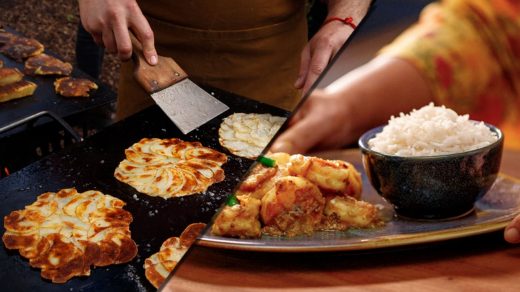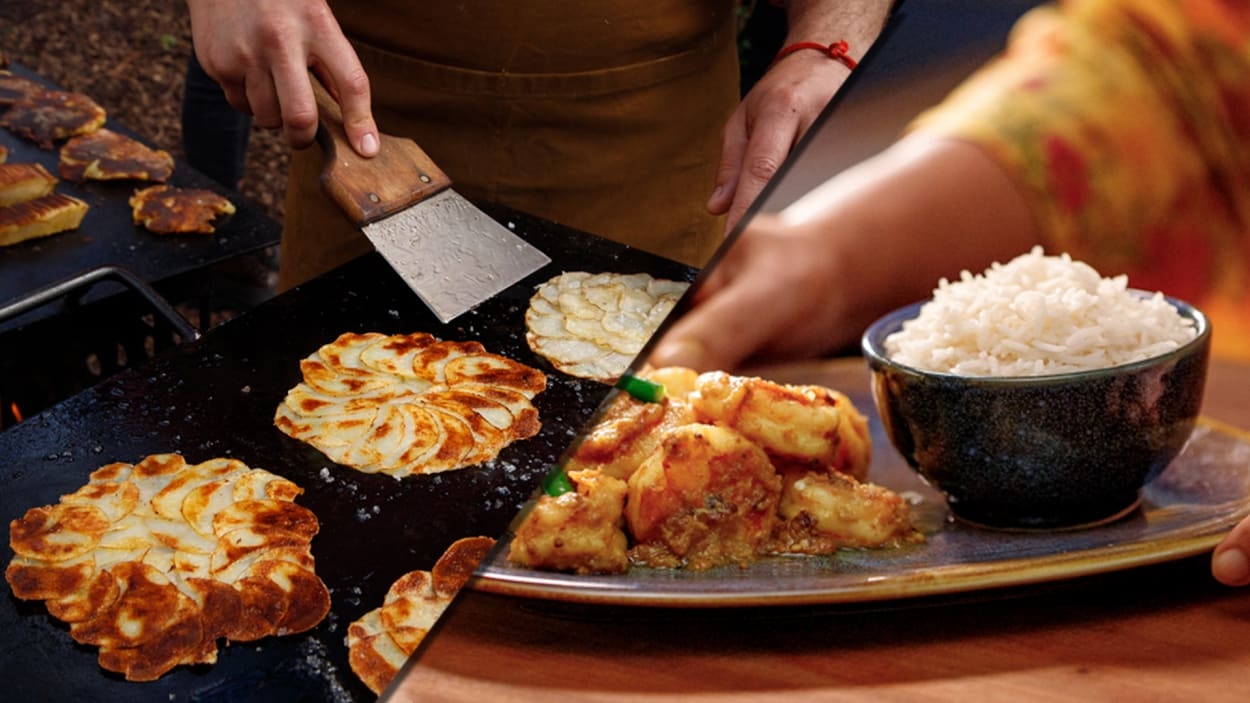I tried the MasterClass for chefs. Here’s what I learned
If your laptop isn’t being flecked with olive oil spatter during a decathlon of online cooking classes, you’re probably doing something wrong. Of course, you’re probably doing something wrong anyway. That’s just the nature of this journey.
After a couple of weeks using YesChef, my laptop was once again in shambles. Shiny smudges on the trackpad. Crusty texture on the keys. And yes, greasy Jackson Pollock oil droplets—the kind that need to be scraped, not scrubbed—all over the screen. There was no time to worry about that, though. Not while juggling two full fry pans for an imminent dinner party. Instead, I had to look past the residue on my screen and do exactly what the tiny Nancy Silverton who lives there commanded, as though she were the rat from Ratatouille. Luckily, the weeks leading up to this moment didn’t just turn my laptop into a backsplash and my kitchen into a test kitchen: They also turned me into a more confident home cook.
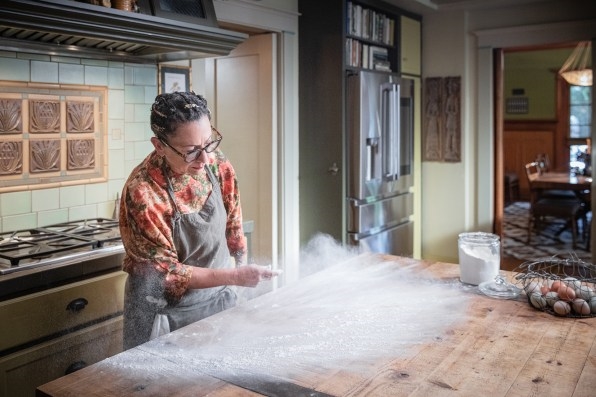
The concept behind YesChef is essentially MasterClass: Whoops, All Cooking Lessons—and that’s intentional. Founder Steve Avery was inspired to build the service after his mother gifted him a Gordon Ramsey MasterClass back in 2017. He enjoyed watching the videos, but never used them as intended, despite Ramsey’s obvious talent as a chef and educator. However, if a service could combine the star power and instructional depth of MasterClass with the intimacy and biographical narrative of Chef’s Table on Netflix, well, Avery figured, that would be right up his alley. The entrepreneur soon put together a business plan and started reaching out to chefs he was interested in shadowing—many of whom he’d first seen on Chef’s Table.
“I basically made YesChef for myself,” he tells Fast Company over Zoom. “I’m customer 001.”
The platform launched in August 2020, with a mission statement built around the belief that “anyone can learn how to cook,” which also happens to be the theme of Ratatouille. I am, more or less, anyone. I find cooking meditative and am borderline competent at it. Following a viral recipe from Bon Appétit, to me, combines the challenge of assembling Ikea furniture with the tastiness of eating plant-based Swedish meatballs on the way out of Ikea. The results don’t always turn out showroom-worthy, though. Part of the problem is that I collapse like a soufflé at phrases like “season to taste.” Even the most rigid recipes require cooks to make a choice or two, and it can be terrifying to be the one in charge of how a flavor experiment turns out.
When I took the same Ramsey MasterClass that inspired Avery, it was as part of an early COVID-19 quarantine experiment in distance learning. But now, almost three years later, I merely wanted to challenge myself. And over the course of two weeks with YesChef, I made 14 dishes, far more decisions, and moved miles outside of my comfort zone. Here’s how it turned out.
Stories on a Plate
Last summer’s hit series The Bear is probably the best thing that could have happened to YesChef—at least in terms of name recognition. The addictive FX drama is mostly set inside a Chicago beef shop, where the main characters constantly say “Yes, chef” to each other. Indeed, Avery gave his platform that name because he wanted users to feel like they were following world-renowned chefs around their kitchens and interacting with them.
But first those users have to choose who they want to follow around. YesChef currently offers courses from seven cooks, all of whom either have Michelin-starred restaurants, James Beard Awards—or both. Because I’m a vegetarian, the only ones I don’t try out are Kwame Onwuachi’s meat-heavy Afro-Caribbean course and Dario Cecchini’s butchery tutorial. That leaves five classes, each with between five and seven hours of video content.
The recipe videos deliver the expected food porn and expertise, but the roughly hour-long introductory “stories” also feature soaring footage of locations like Kolkata, Panicale, and Chef Francis Mallmann’s private island in a remote corner of Patagonia. These longer videos give viewers an opportunity to see where the chefs are coming from—geographically, influence-wise, and also just as people. In at least three cases, we also meet their romantic partners.
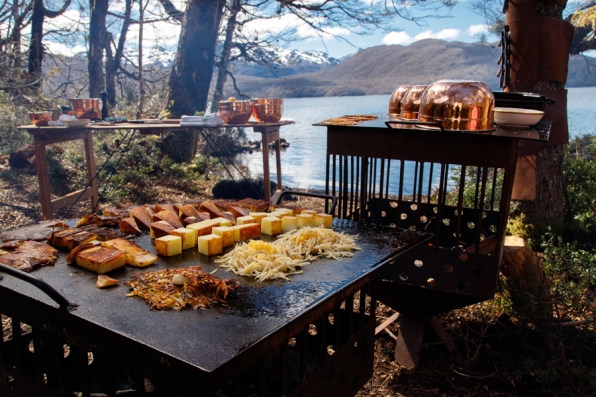
Mallmann, the pioneer of open-fire grilling, draws me in right away with his knowledge, passion, and eccentricity. He dresses with the precise aesthetic of a Wes Anderson character and has an immense philosophical respect for fire. (“The moment you see fire,” he says at one point, “you recognize something that was inside of you long before you were born.”) Viewers meet the chef amid a shakeup in his intensely loyal crew—his fire director is moving on—and watch the team put together a bountiful feast that is long on potatoes, the primary ingredient in Latin American cuisine. By the time the video ends, I am primed to learn some of the literal dozen methods that Mallmann teaches in his 30-minute video, “Potatoes: A Love Affair.”
The longer videos also offer the first hints of YesChef’s factoid factor; the fascinating tidbits tossed out along the way, perhaps to be redistributed among viewers’ dining companions. As Chef Asma Khan gives us a tour of Kolkata, for instance, she explains how the international spice trade influenced which foods became native to India. Her videos don’t just teach recipes, they also explore flavor profiles and illuminate Indian culture. A journalist featured in her introduction says of the chef, “Asma is not about food, she’s about stories on a plate.”
Watching these videos makes me hungry for both.
Diving into the Deep End of the Skillet
Eggplants have always filled me with primal terror. When prepared correctly, they taste fantastic, but in the wrong hands, they become seed-filled sponge-blobs that can ruin your day. I’ve never dared cook something with such little room for error.
Not until now, anyway.
In one of my first lessons with YesChef, Khan guides me through the smoky pitfalls of baingan bharta (eggplant mash), my go-to order at Indian restaurants. I click on the dish and set to work. On the left side of my screen, a video shows the chef preparing her meal; while on the right, I toggle between an Ingredients tab and one listing the Recipe. As I follow along, Khan seems to anticipate my questions before they occur to me. Her written recipe says to “remove the skin” and “place the flesh in a bowl,” as though I’m capable of intuiting how to do so myself, but in the video she deftly slices open her charred eggplant and starts scooping out the meat with a spoon. The baingan bharta I make with her assistance isn’t quite restaurant-caliber, but it’s rich and thick and tastes like baingan bharta. Either my fears about eggplant were unfounded, or this level of instruction makes cooking them foolproof.
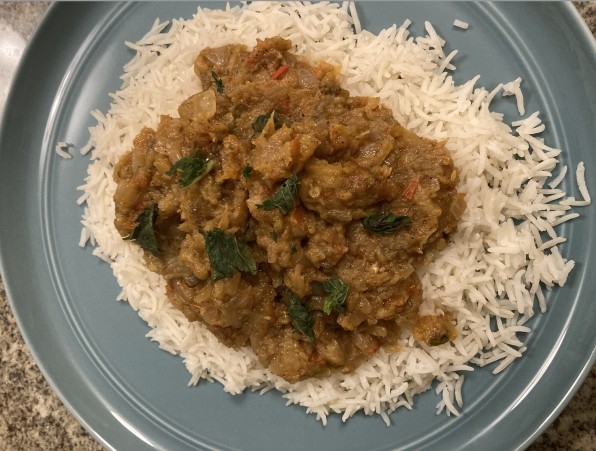
[Photo: Joe Berkowitz]
Because I am a glutton for punishment, I choose another eggplant-based dish next, moving from Kolkata to Argentina with Mallmann’s eggplant milanesa. Again, the video proves immensely helpful. I’m not sure how I would’ve interpreted the written instructions to simply “coat” a peeled eggplant with bread crumbs, but I definitely wouldn’t have thought to dunk the yolk-soaked eggplant in a pan filled with them and roll it around like a bread crumb snowball. The dish takes far longer to make than the 40 minutes listed, and there are too many cracks in the fillet’s golden-brown shell, but it comes out shockingly tasty, with just the right chew.
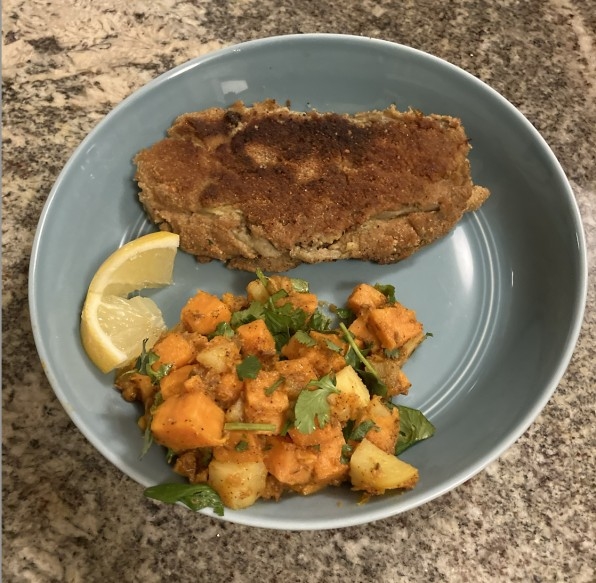
This time difference proves typical. Everything takes longer to make than I think it will. Perhaps it has something to do with the disparity in equipment. Both chefs Khan and Mallmann cooked their eggplants directly in the embers of a fire, for instance, and I used the coward’s method of putting them in an oven. While Mallmann cooked his fillets on a plancha, I had to settle for the suggested alternative of a cast-iron skillet. I had never even heard of a plancha before.
This kind of immersion in cheffy cooking classes is a great way to discover just how much equipment your kitchen is missing. While it’s entirely possible to get by without Mallmann’s beloved plancha, several other utensils don’t have alternatives. Nancy Silverton’s peperonata requires a food mill, which I do not own. The recipe for falafel, paradoxically, calls for a meat grinder. Although I do have a mortar and pestle, which is needed for making hummus, I do not have one spacious enough to accommodate 500 grams of chickpeas.
Some dishes I stay away from because of missing equipment or such hard-to-procure ingredients as watermelon radish. Eventually, though, I start to see these roadblocks as opportunities for improvisation and kitchen creativity—another form of “seasoning to taste.” It’s an attitude that several instructors on YesChef actively encourage.
“When I cook, I try to free myself from any restrictions. Not to cook with my head, but with my stomach,” Chef Erez Komarovsky says during one lesson. “It’s like being a jazz musician. You just do.”
Starting with the eggplant milanesa, I decide to go off-roading whenever the situation calls for it. Just before dipping my eggplant in yolk and bread crumbs, I feel a ridge of seeds somewhere inside. The texture is hard, almost sharp. There’s a chance I’m supposed to leave these rows of seeds in the fillet; that the heat from the pan will alchemize them into edibility, perhaps even succulence. This is how institutionalized I am with cooking—if the recipe doesn’t explicitly say to do something, I’m too afraid to deviate. Not this time, though. I strip out the four or five seedy ridges lurking within the eggplant and throw them away. Judging by taste, it was the right move.
Further snap decisions follow. When my first saag paneer isn’t spicy enough, I call an audible during my second attempt and sub in jalapenos instead of green chilis. I also pour heavy cream into the spinachy dish while it’s still cooking, rather than just before serving, which ends up giving it a more stew-like consistency. It’s still not restaurant quality, but it’s closer.
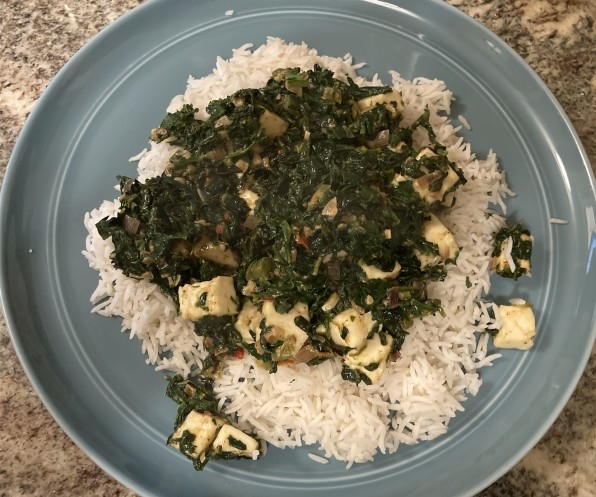
I’m no longer just listening to the tiny chefs on my screen, I’m also listening to my gut.
The Inexact Science of Culinary Forensics
As helpful as it is to see chefs use the extra space and dimensionality of video to expand on the how of a recipe, it’s nourishing to get more of the why. Although Mallmann can go off on poetic flights of fancy—describing the sizzle of butter and thyme as the two ingredients “laughing together”—he also tends to explain why he’s doing what he’s doing as he’s doing it. The potatoes in my tortilla should be cut thick, he says, so that they don’t overcook, and I need to keep adding ghee to my domino potatoes (which are exactly what they sound like) so that they remain moist. All of the chefs on the platform round out their recipes with similar insights to one degree or another.
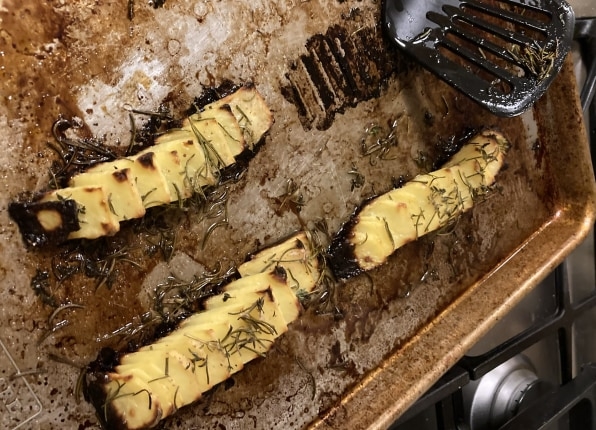
Sometimes, their running commentary on the food reveals more about their personalities. As runny yolk sluices through tomato geysers in my shakshuka, I don’t think anything of the fact that Komarovsky prescribes burrata, an Italian cheese, for this classically Israeli dish. Being the so-called godfather of modern Israeli cuisine, though, he feels a need to get ahead of the question. The chef explains that Israel started importing good burrata in recent years, making it a trendy addition to menus all over the nation. Any viewers who don’t want to use burrata, he says, can try jibneh, a Syrian cheese that is more authentic to the Middle East. Even though he is a representative of his region, the chef likes what he likes. His tradition-bucking shakshuka ends up being the best dish I make during this experiment, its robust spice mellowed by the buttery burrata.
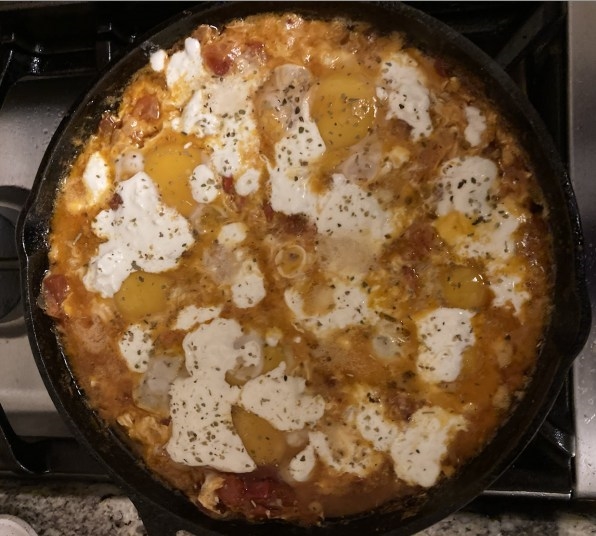
The cheese in this recipe is a salute to coloring outside the lines, which is something I have to do myself while making it. Sometimes on YesChef, a discrepancy will emerge between the amount of ingredients listed and the amount the chefs deploy. The shakshuka recipe, for instance, calls for “two kilograms of ripe tomatoes,” which is so much ripe tomatoes. I weigh the multiple bunches I purchased and it totals out to just over a kilogram. In the video, though, Komarovsky calls instead for “a good amount of tomatoes,” and uses roughly the number I have on hand—which turns out to be enough. Something similar happens with the olive oil in this dish. The recipe calls for two cups, which seems like too much, while the chef again recommends “a good amount” of olive oil. I have no idea how much I actually pour in, but miraculously it’s the perfect amount. I try to retrace my steps afterward, to remember how much to use next time.
This ends up being the only time where, after cooking with YesChef, I wondered where I went right. More often, I found myself performing forensic analysis on a culinary crime scene.
This is where I tell you about all the failures I experienced during the course of this project. The caramelized carrots where the cream refused to reduce. The caramelized cashews where the caramelization and the cashews had irreconcilable differences. The potatoes in my tortilla were cut thick, so as not to overcook, but they ended up being too chunky to submerge properly within the eggy base.
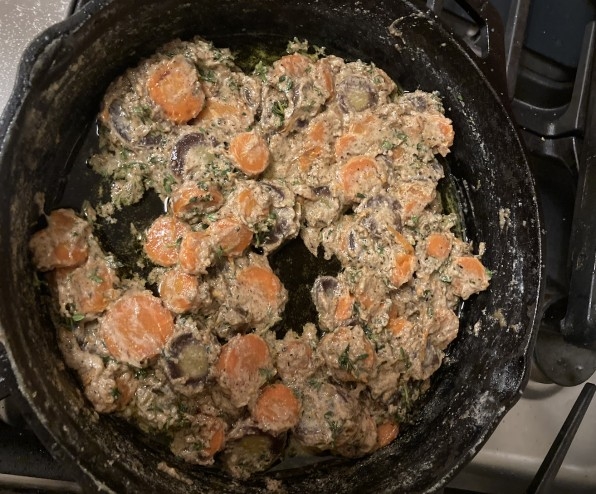
Like splashes of olive oil on my laptop, the mystery of why certain recipes didn’t quite come together is also part of this journey.
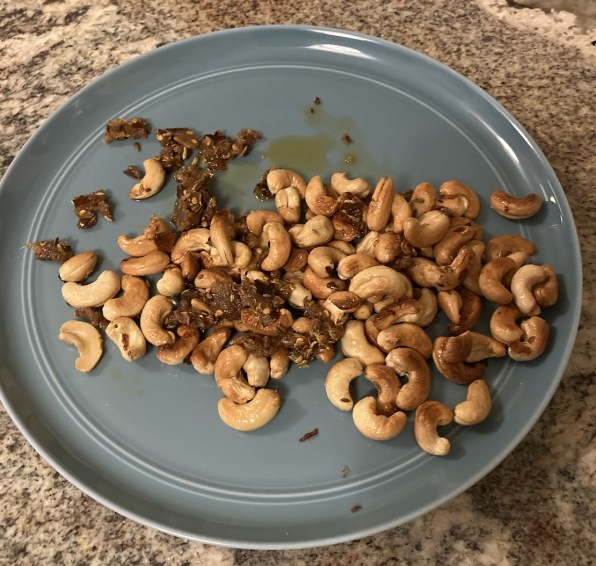
Even the dishes that went wrong, though, still taste the good kind of interesting. I have no idea why those cashews rejected caramelization, but at least I now know that the mélange of fennel seeds, ground chilies, and sugar against cashew-umami is a flavor I want in my life.
The Dinner Party
For skittish home cooks, a dinner party can be a total nightmare. It’s a symphony of decision-making and multitasking, and in the end, an entire audience is present to witness it. If anything goes wrong with the main dishes, the night will culminate in a pizza delivery of shame.
Naturally, I invited another couple over for dinner as the ultimate YesChef stress test.
Only after inviting this couple did I remember that they are vegans, which puts a large limitation on dinner possibilities. Sifting through the options, though, I slowly but surely design a promising, vegan-friendly meal. As an appetizer, I would serve Nancy Silverton’s olive tapenade with focaccia bread. For the main course: her stewed celery with herbs and Persian lime, supported by Asma Khan’s matar pulao on the side. For dessert: Mallman’s burnt fruit with (soy) cream.
I start prepping dinner with four hours on the clock. My laptop sits atop the kitchen island, surrounded by an ocean of ingredients, grouped by their corresponding dishes. The first order of business is the tapenade, which I can get out of the way early and stash in the fridge. It’s a breeze—one of those recipes with only a handful of steps, the first of which is “dump nearly everything in a bowl.” The tapenade tastes bright and briny, with a floral tang. I never would’ve imagined orange zest meshing with olives, but that’s why I’m taking lessons instead of giving them.
Moving on to the main course, the rice for the matar pulao needs to soak in water for at least a half hour before cooking. Khan says this method will produce fatter grains that are less likely to stick to the pan, precisely the kind of factoid I can file away in my head to mention over dinner, which I do. The rice will have plenty of time to soak since the stewed celery is going to take lots of prep work. I switch over to peeling celery, which is something I had no idea you are supposed to do, but which Silverton says will help it cook more evenly and consistently.
Once everything is prepped, I start actually cooking both halves of the main course, toggling between two open YesChef tabs on my laptop. It’s a schizophrenic experience. One moment, Khan is asking me to remove whole cloves from a pan of vegetable oil with a slotted spoon; the next, Silverton is telling me to stir turmeric into my onions until the color is evenly distributed. There are now two Ratatouille rodents guiding my hands, and they are not taking turns. I may be in over my head.
The turning point arrives when the rice and peas are finally simmering in spiced oil and boiling water and I can focus more attention on the stewed celery. Unfortunately, this is also the moment when I realize something has gone horribly wrong with this dish. Either the dried Persian lime is too aggressively bitter, or I used too much of it. In any case, it has taken over the dish by storm. This was the one wild ingredient I went far out of my way to pick up, at an Iranian market, and now it has turned against me. I feel betrayed. The dinner party is now in trouble, and neither Nancy Silverton nor any of the other chefs can save it. I can only save it myself.
Since the dish is already ruined, I have nothing to lose by getting weird with it. The only thing that can repel the force of that aggressive lime powder, I decide, is an equal and opposite reaction. This stewed celery needs some sweetness—stat! I dump in a heaping tablespoon of sugar. I add pomegranate seeds and pine nuts for good measure. Komarovsky’s prophecy has been fulfilled: I’m certainly playing jazz now.
Incredibly, it works. The sweetness sands the edges off the bitter kick in each bite, and the pine nuts and pomegranate seeds add a faint crunch to the texture. It wasn’t a dish anyone would ever actively seek out in any multiverse, but it was indeed serveable. Dinner was saved.
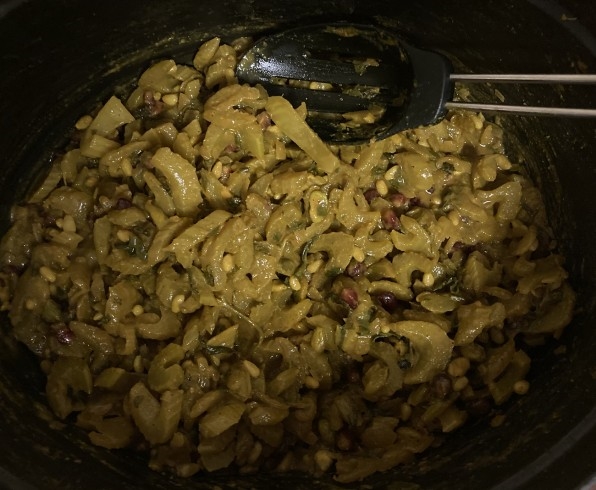
Our guests can only laugh when I tell them how their meal came together, but they seem to genuinely enjoy it. I’m so relieved to be done cooking, though, that I nearly forget about dessert, our burnt fruit and soy cream. We almost decide to skip it. However, the idea of closing out the YesChef experiment with a dish that went sideways doesn’t sit right with me. Everyone shuffles into the kitchen and starts peeling oranges and grapefruits together. Once more, into the skillet they go. Not only does the fruit taste great caramelized, it’s easy enough to cook that having an audience around is actually fun. It’s like dinner theater.
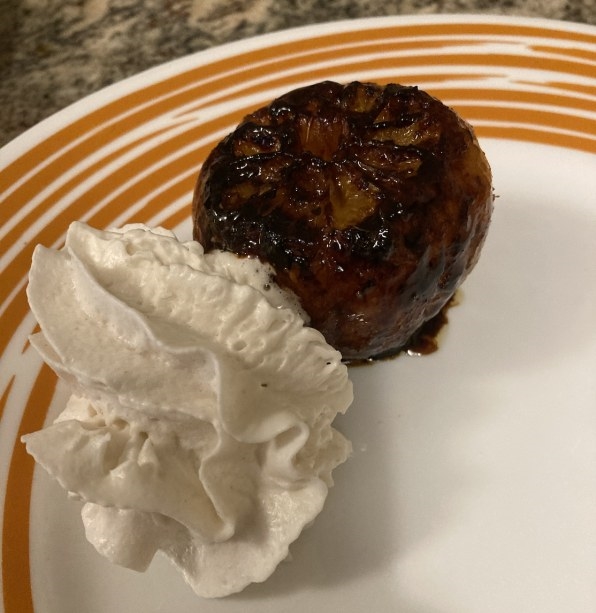
During Mallmann’s introductory video, one of his assistants says of the chef, “He’s a great creator. He creates everything, not just a recipe. He creates moments.”
Following a variety of inspired chefs around their kitchens for two weeks of instruction brought some of that generative spirit into my own kitchen. This is the secret ingredient in a platform like YesChef, maximizing the momentness of a meal. Having the motivation and means to cook dishes out of the ordinary—at a level beyond what you ordinarily cook—is bound to produce something more than just food. It turns cooking into an event. It puts stories on a plate.
(45)

